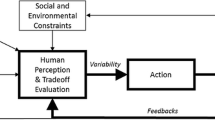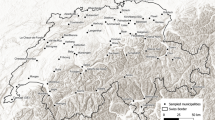Abstract
Land use patterns and land form are important sources of information that contribute to the formation of landscape perceptions and values. This paper discusses three concepts of human-landscape relationships: the human as an agent of biological and physical impacts on the landscape; the human as a static receiver and processor of information from the landscape; and the human as an active participant in the landscape —thinking, feeling and acting — a transactional concept. A model of the transactional concept and of human perception and response is presented along with a conjectural example of human-landscape transactions. Three empirical research projects are presented to illustrate varying relationships between and among humans and landscapes. Variations in human experiences, needs and desires, personal utility functions for the use of the landscape, and socio-cultural contexts are suggested as mediating variables on perceived values and human responses. The importance of landscape values information to planning and management activities is discussed.
Similar content being viewed by others
References
Bennett, J. 1980. Social and interdisciplinary sciences in U.S. MAB.In Social Sciences, Interdisciplinary Research and the Man and the Biosphere Program, pp. 17–39. Edited by E.H. Zube. U.S. State Department, Washington D.C.
Blissett, M. (ed.) 1975. Environmental Impact Assessment. Austin, Texas.
Charney, A. 1986. Migration: long run trends in Arizona. Ariz. Econ. Dec.: 1–2.
Crowe, S. 1969. Landscape Planning. International Union for the Conservation of Nature and Natural Resources, Morges, Switzerland.
Daniel, T.C. and Vining, J. 1983. Methodological issues in the assessment of landscape quality.In Behavior and the Natural Environment. pp. 39–84, Edited by I. Altman and J.F. Wohlwill Plenum Press, New York.
Forman, R.T.T. and Godron, M. 1986. Landscape Ecology. John Wiley & Sons, New York.
Ittelson, W. 1973. Environmental perception and contemporary perceptual theory.In Environment and Cognition, pp. 13–15. Edited by W. Ittelson. Seminar Press, New York.
Klecka, W.R. 1980. Discriminant Analysis. Sage Publications, Beverley Hills, California.
Naveh, Z. 1985. Landscape ecology — A bridge between bio-ecology and human-ecology. Hum. Ecol. Bull. 3: 7–9.
Sell, J.L., Zube, E.H. and Kennedy, C.L. 1987. Perception of Land Use Change in a Desert City. (unpublished manuscript).
Sinden, J.A. and Worrell, A.C. 1979. Unpriced Values John Wiley & Sons, New York.
U.S.D.I. Fish and Wildlife Service, Region II. 1978. Unique Wildlife Ecosystems of Arizona. Albuquerque, New Mexico.
Van der Zee, D. 1982. The impact of recreation on the rural landscape.In Perspectives in Landscape Ecology. pp. 148–149. Edited by S.B. Tjallingi and A.A. de Veer. Pudoc, Wageningen.
Wohlwill, J.F. and Zube, E.H. 1980. The role of the social sciences within U.S. MAB.In Social Sciences, Interdisciplinary Research and the U.S. Man and the Biosphere Program. pp. 2–16. Edited by E.H. Zube. U.S. State Department, Washington, D.C.
Zube, E.H. and Law, C.S. 1981. Natural resource values and landscape planning.In Regional Landscape Planning. pp. 64–71. American Society of Landscape Architects, Washington, D.C.
Zube, E.H. and Sell, J.L. 1986. Human dimensions of environmental change. J. Plann. Literat. 1(2): 162–176.
Zube, E.H. and Simcox, D.E. 1987. Arid lands riparian landscapes and management conflicts. J. Environm. Managem. (forthcoming).
Zube, E.H., Sell, J.L. and Taylor, J.G. 1982. Landscape perception: research, application and theory. Landsc. Plann. 9: 1–33.
Zube, E.H., Pitt, D.G. and Evans, G.W. 1983. A lifespan developmental study of landscape assessment. J. Environm. Psychol. 3: 115–128.
Zube, E.H., Law, C.S. and Carpenter, E.H. 1984. Arizona survey reveals anti-development attitude. Lands. Arch. 74(6): 97–100.
Author information
Authors and Affiliations
Rights and permissions
About this article
Cite this article
Zube, E.H. Perceived land use patterns and landscape values. Landscape Ecol 1, 37–45 (1987). https://doi.org/10.1007/BF02275264
Issue Date:
DOI: https://doi.org/10.1007/BF02275264




